CBS Beck 8x40
Dänisches PeilvisierDas vorliegende Beck 8x40 Monokular wurde für die Dänische Marine als Peilvisier aus einer rechten Fernglashälfte umgebaut. Am der vorderen Seite des Aufbewahrungskasten aus Holz ist ein kleines Blechschild aufgeschraubt. Dies hat die Abnahmenummer 51 sowie eine Dänische Krone und die Buchstaben "FK" als Abkürzung für "Flådens Kompasmagasin", das Kompasszeugamt der Dänischen Marine. Das Zeugamt kontrollierte und justierte zwischen den beiden Weltkriegen, ggf. auch bis 1949, Kompasse und anderes Zubehör. Der Kasten hat zusätzlich einen Aufkleber mit der Beschriftung "Kikkert11 6254".Das Beck 8x40 ist ein unvergütetes Porro-1-Modell mit konischem Objektivtubus. Die einfach verschraubten Deckel sind schwarz lackiert. Der obere ist mit dem "Beck Kassel", dem "CBS"-Logo und "8x40" beschriftet, der untere mit der Krone und "FK". Am Objektiv-seitigem Brückenfuß ist "Nr. 1" eingestempelt". Das Gehäuse hat eine eingegossene Trageriemenöse und ist, wie der Objektivtubus, mit einem Leder ummantelt. Die Augenmuschel ist aus Kunststoff, die Dioptrienskals am linksseitigem Okular komplett umlaufend und bei null und +/- Fünf markiert. |
Danish Director SightThis Beck 8x40 monocular was converted from a right half of binoculars for the Danish Navy as a direction finder. A small tin sign is screwed to the front of the wooden storage box. This has the acceptance number 51 as well as a Danish crown and the letters "FK" as an abbreviation for "Flådens Kompasmagasin", the Danish Naval Compass Arsenal. The arsenal checked and adjusted compasses and other accessories between the two world wars, possibly also until 1949. The box also has a sticker that says "Kikkert11 6254".The Beck 8x40 is an uncoated Porro 1 model with a conical objective tube. The covers have only one screw and are painted black. The upper one is inscribed with "Beck Kassel", the "CBS" logo and "8x40", the lower one with the crown and "FK". The bridge arm on the obejctive sid is stamped "Nr. 1". The housing has a cast-in strap-lug and, like the objective tube, is covered with leather. The eyecup is made of plastic, the diopter scale on the left-hand eyepieces run all the way around and are marked at zero and +/- five. |
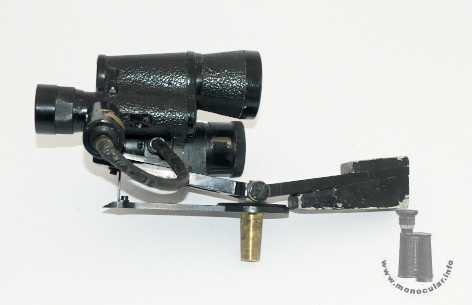
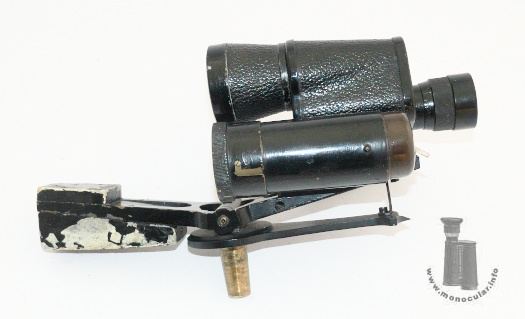
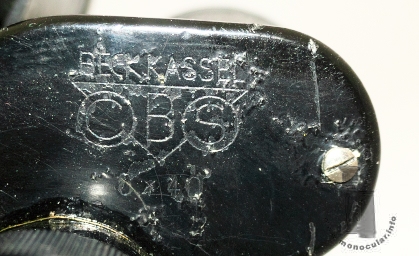
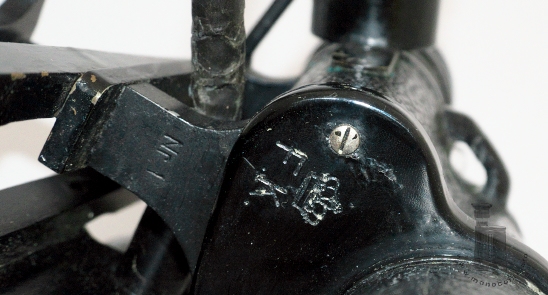
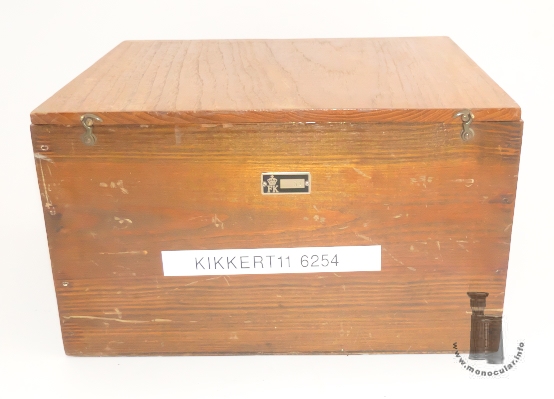
| Für die Verwendung als Peilvisier hat das 8x40 eine Fadenkreuz-Strichplatte und eine Beleuchtungseinheit aus einem zylindrischen Batteriebehälter mit Stromschalter und Verschlussdeckel sowie ein Kabel mit Glühbirnenfassung erhalten. Die Birnenfassung ist auf die Hülse am Strichplattenfenster aufgeschraubt. Die Hülse selbst hat einen gebogenen Stabiliserungsarm, der mit der Montageplatte an den Brückenfüßen verbunden ist. Die Brückenfüße des Monokulars sind mit der Montageplatte am hinteren Teil eines Unterteils eines analogen Peilvisiers angeschraubt. Der Batteriebehälter ist mit einer gebogenen Montageplatte ebenfalls hinten seitlich am Peilvisierunterteil angeschraubt. Das Visierunterteil ist unten mit "FK X." und Nr. 51 (analog zur Kastennummer) gestempelt. Dabei wurde wohl bei der ursprünglichen "Nr. 1." (s. o. Beschriftung am Brückenfuß) über den 1. Punkt eine kleinere 5 gestempelt. Nahe des Stativzapfens gibt es noch eine "4." (Teilenummer?). Das originär leicht kippbare Visierunterteil wurde hinten mit einem Metallstück fixiert und am vorderen Teil wurden Gegengewichte geschraubt. |
For use as a sight, the 8x40 has received a crosshair reticle and an illumination unit consisting of a cylindrical battery case with a power switch and locking cap, and a cable with a light bulb socket. The bulb socket is screwed onto the sleeve on the reticle window. The sleeve itself has a curved stabilizing arm that connects to the mounting plate at the bridge feet. The bridge feet of the monocular are screwed to the mounting plate on the rear part of a lower part of an analog sight. The battery case is also screwed to the rear side of the lower part of the sight with a curved mounting plate. The lower part of the sight mount is marked "FK X." and stamped No. 51 (same as the number on the box). It probably was originally "No. 1." (cf. above, stamp on the bridge arm), then a smaller 5 stamped over the 1st dot. There is another "4." near the tripod pivot (part number?). The originally slightly tiltable lower part of the visor was fixed with a piece of metal at the back and counterweights were screwed onto the front part. |
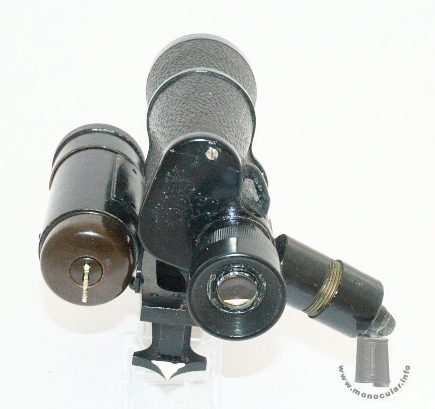

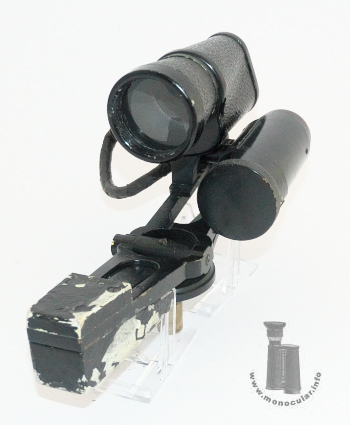
| Der Kasten für das Peilvisier enthält auch ein analoges Peilvisier, dessen oberes Teil sich kippen lässt. An der Vorderseite kann ein länglicher Metallrahmen hochgeklappt werden; diese hat einen senkrechte Visierdraht und eine nach vorne zeigende Spitze mit einem Peilstrich. Am hinteren Teil sind zwei Peilstücke mit jeweils zwei Zinken aufgeschraubt. Beide fungieren als eine Art "Kimme und Korn". Auf der oberen Seite ist eine weiße Leuchtfarbe angebracht. | The box for the sight also contains an analogue director sight, the upper part of which can be tilted. An elongated metal frame can be folded up at the front; this has a vertical sighting wire and a forward-pointing tip with a sighting line. Two gauges, each with two prongs, are screwed onto the rear part. Both act as a sort of "bead and sight". A white luminous paint is applied to the upper side. |
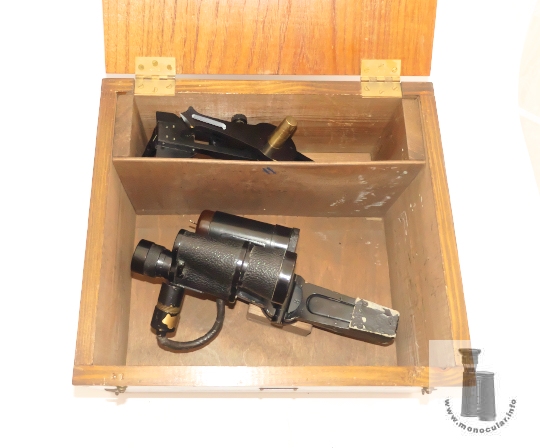
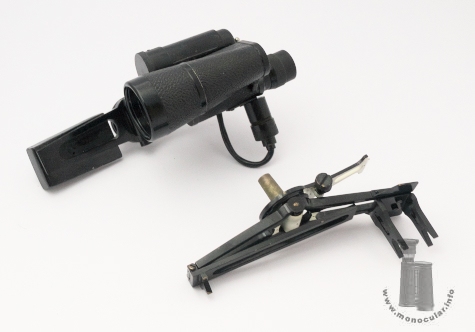
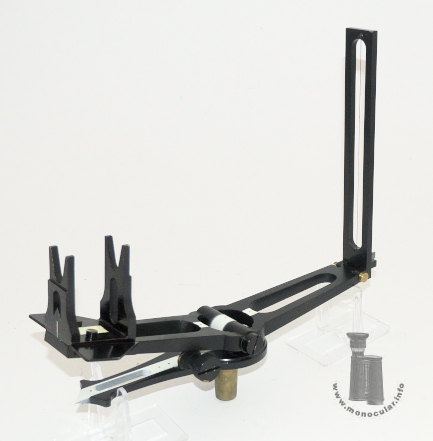
| Das 8x40 Monokular ist 149-153 mm lang, das Gehäuse ist oben 53 x 51 mm und unten 56 x 51 mm breit, das Okularstück ist 28 mm, der Fokussierungsring 32 mm und die Augenmuschel 33 mm im Durchmesser, während sich der Objektivtubus von 40 auf 48 mm im Durchmesser verbreitert. Das monokulare Peilvisier mit der Montage und Beleuchtungseinheit wiegt 1893 g. Das analoge Visier wiegt 800 g. Der 10 cm lange Batteriebehälter ist 39 mm im Durchmesser und das 4 cm lange Lampengehäuse 25 mm im Durchmesser. Das Montageunterteil ist 225 mm lang. Der Stativzapfen ist 33 mm lang.
Vgl. auch das Leitz 7x50 Peilvisier. |
The 8x40 monocular is 149-153mm long, the body is 53 x 51mm wide at the top and 56 x 51mm at the bottom, the eyepiece is 28mm, the focusing ring is 32mm and the eyecup is 33mm in diameter, while the obejctive tube increases from 40 to 48 mm in diameter. The monocular sight with its assembly and lighting unit weighs 1893 g. The analogue sight weighs 800 g. The 10 cm long battery case is 39 mm in diameter and the 4 cm long lamp housing is 25 mm in diameter. The mounting base is 225 mm long. The tripod rod is 33 mm long.
Also cf. Leitz 7x50 sight. |
Fotos: Zeun

